Genetic origins of Down syndrome
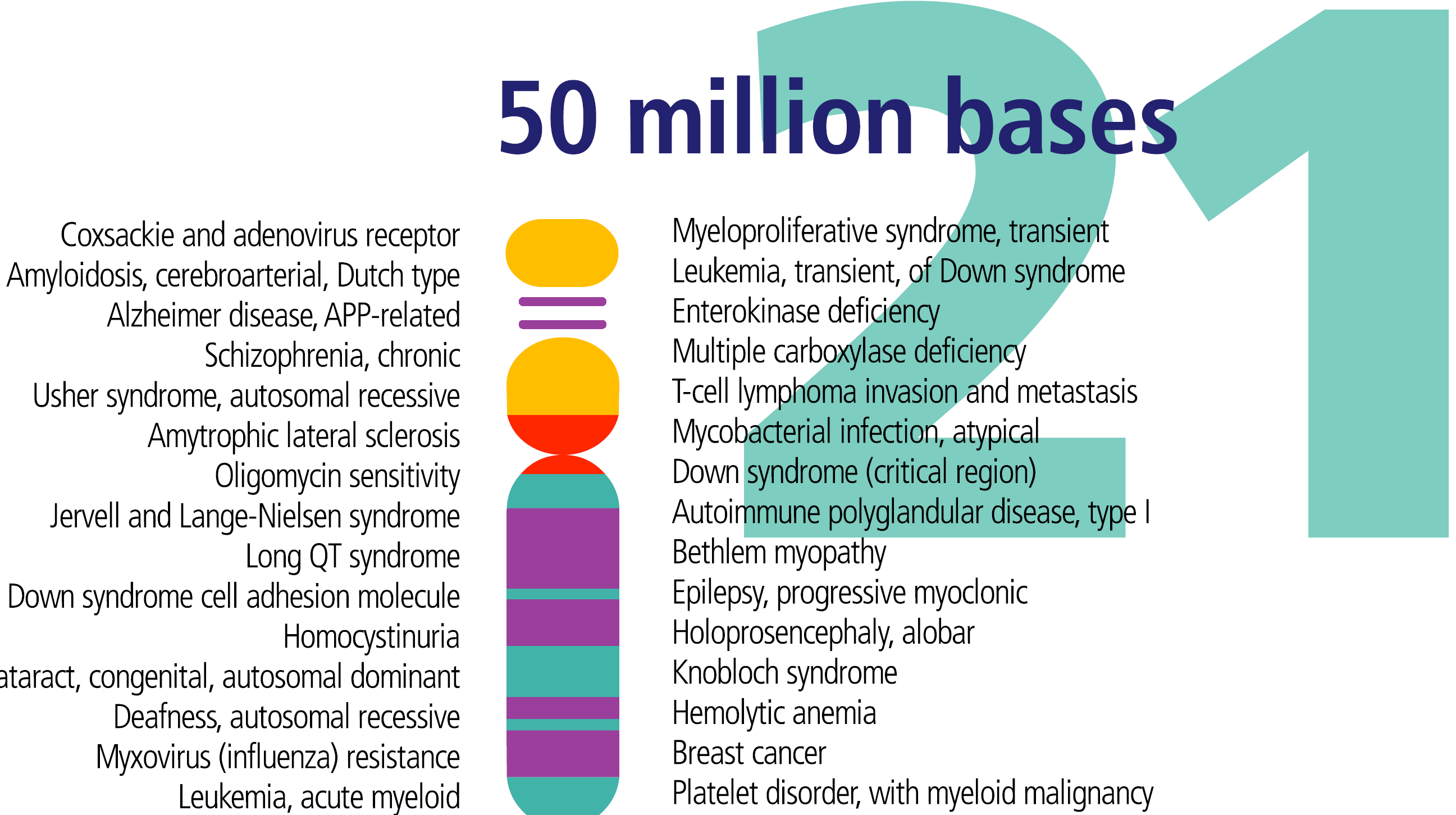
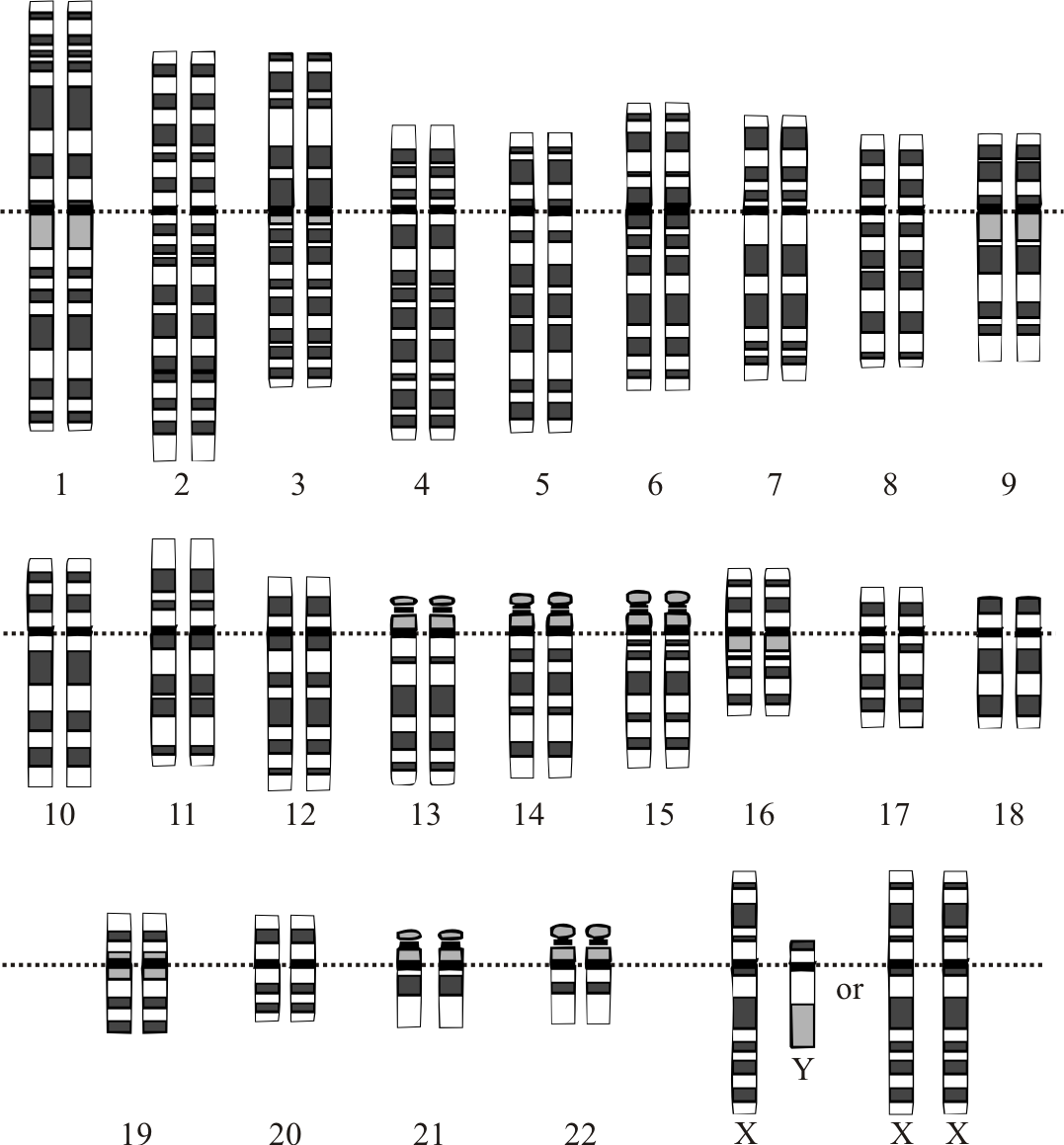
Down syndrome is a chromosomal abnormality characterized by the presence of an extra copy of genetic material on the 21st chromosome, either in whole (trisomy 21) or part (such as due to translocations). The effects of the extra copy varies greatly from individual to individual, depending on the extent of the extra copy, genetic background, environmental factors, and random chance. Down syndrome can occur in all human populations, and analogous effects have been found in other species, such as chimpanzees and mice. Recently, researchers have been able to create transgenic mice with most of human chromosome 21 (in addition to their normal chromosomes).[1]
A normal human karyotype is shown here. Every chromosome has two copies. In the bottom right, there are chromosomal differences between males (XY) and females (XX), which do not concern us. A normal human karyotype is designated as 46,XX or 46,XY, indicating 46 chromosomes with an XX arrangement for females and 46 chromosomes with an XY arrangement for males.[2] For this section, we will use females for the karyotype designation (46,XX).
The extra chromosomal material can come about in several distinct ways. These are explained in the following sections.
Trisomy 21
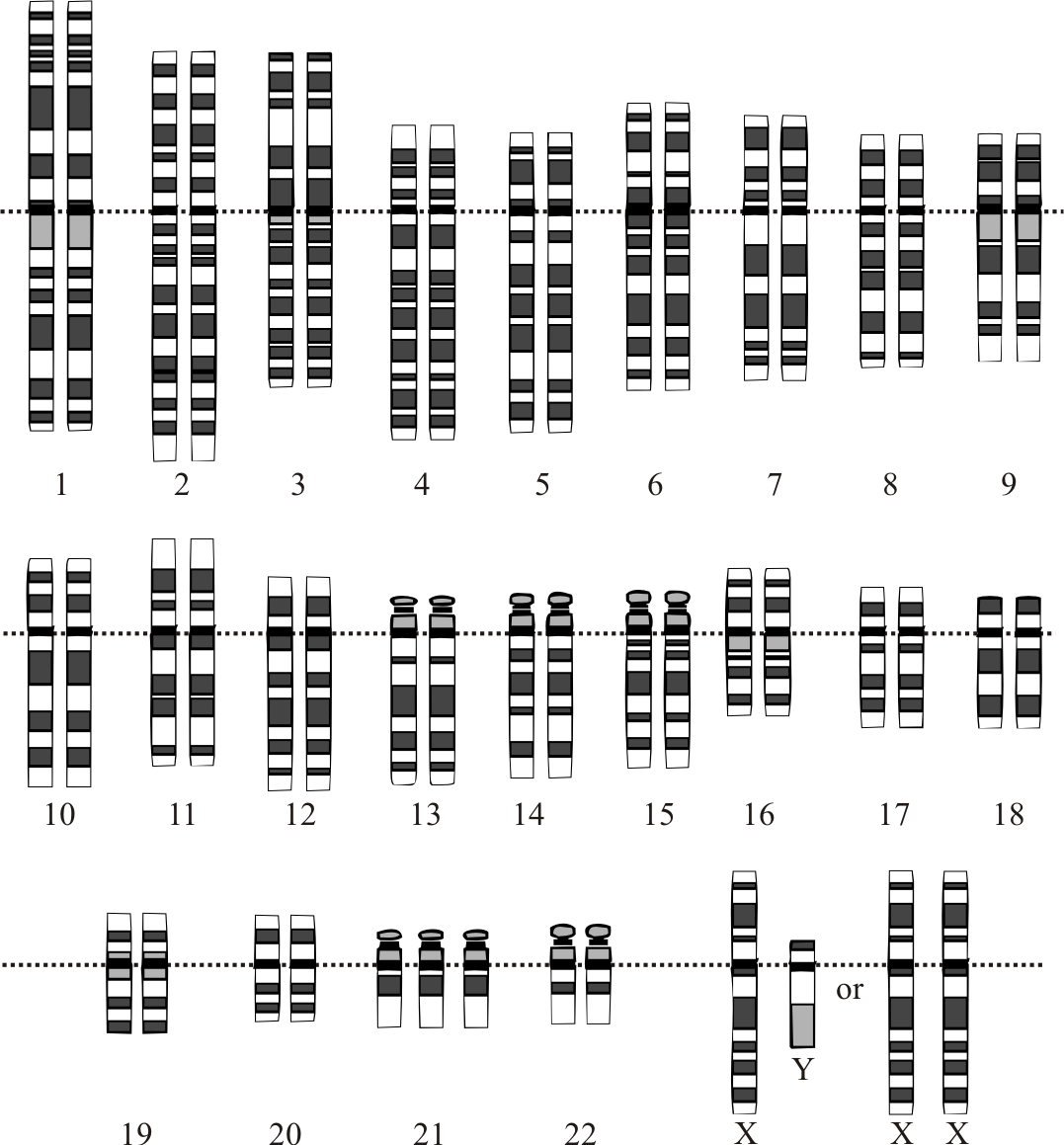
Trisomy 21 (47,XX,+21) is caused by a meiotic nondisjunction event.[3] A normal gamete (either egg or sperm) has one copy of each chromosome (23 total). When it is combined with a gamete from the other parent during conception, the child has 46 chromosomes. However, with nondisjunction, a gamete is produced with an extra copy of chromosome 21 (the gamete has 24 chromosomes). When combined with a normal gamete from the other parent, the child now has 47 chromosomes, with three copies of chromosome 21. The trisomy 21 karyotype figure shows the chromosomal arrangement, with the prominent extra chromosome 21.
Trisomy 21 is the cause of approximately 95% of observed Down syndromes, with 88% coming from nondisjunction in the maternal gamete and 8% coming from nondisjunction in the paternal gamete.[4] Mitotic nondisjunctions after conception would lead to mosaicism, and is discussed later.
There has been reported some cases of Down syndrome parents having trisomy 21 children.[5] In these cases (all from mothers), the ovaries were trisomy 21, leading to a secondary nondisjunction during gametogenesis and a gamete with an extra chromosome 21. Such Down syndrome trisomies are indistinguishable from Down syndrome trisomies created through meiotic nondisjunction.
Robertsonian translocation
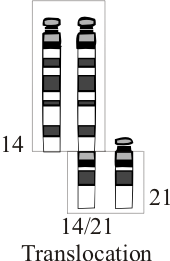
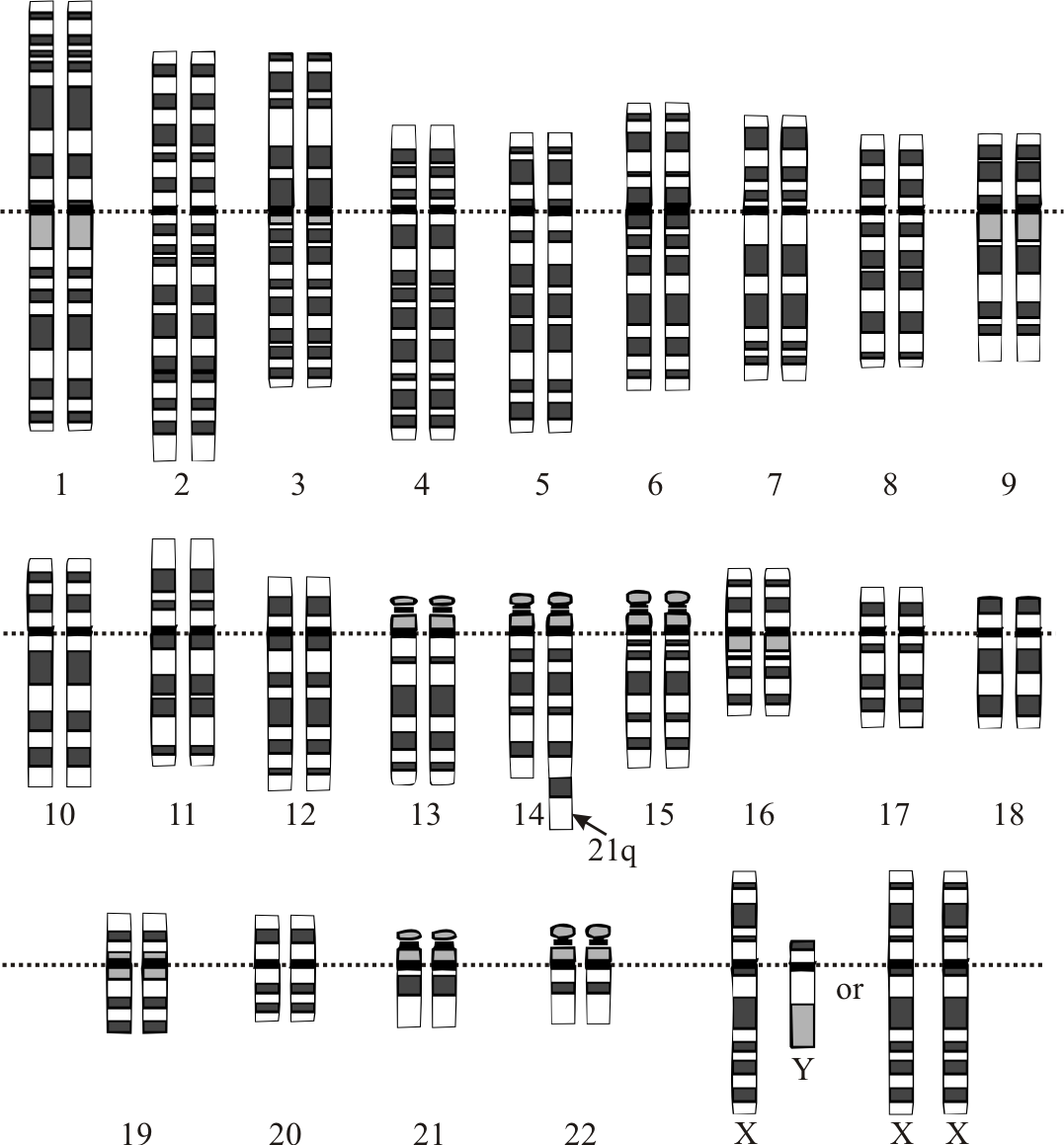
The extra chromosome 21 material that causes Down syndrome may be due to a Robertsonian translocation. The long arm of chromosome 21 is attached to another chromosome, often chromosome 14 (45,XX,t(14;21q)) or itself (called an isochromosome, 45,XX,t(21q;21q)) as seen in the translocation karyotype figure.
Translocation Down syndrome can be de novo; that is, not inherited but occurring at the time of an individual's conception, or may be inherited from a parent with a balanced translocation. The balanced translocation figure shows a 14/21 translocation, where the other chromosomes are not shown. The individual has two copies of everything on chromosome 14, and two copies of all of the material on the long arm of chromosome 21 (21q). The individual only has one copy of the material on the short arm of chromosome 21 (21p), but this appears to have no discernable effect. Individuals with this chromosomal arrangement are phenotypically normal. During meiosis, the chromosomal arrangement interferes with normal separation of chromosomes. Possible gametic arrangements are: Normal 14 and normal 21; Translocated 14/21 and normal 21; Translocated 14/21 only; Normal 14 only. When combined with a normal gamete from the other parent, the last is lethal, leading to spontaneous abortion. The first, combined with a normal gamete from the other parent, gives rise to a normal child. The second leads to a translocation Down syndrome child (see translocation karyotype figure). The third becomes a translocation carrier, like the parent.
Translocation Down syndrome is often referred to as familial Down syndrome. It is the cause of 2-3% of the observed Down syndromes.[4] It does not show the maternal age effect, and is just as likely to have come from fathers as mothers.
Mosaicism
Mosaic Down syndrome is when some of the cells in the body are normal and some cells have trisomy 21, an arrangement called a mosaic (46,XX/47,XX,+21).[6] This can occur in one of two ways: A nondisjunction event during an early cell division leads to a fraction of the cells with trisomy 21; or a Down syndrome embryo undergoes nondisjunction and some of the cells in the embryo revert back to the normal chromosomal arrangement. There is considerable variability in the fraction of trisomy 21, both as a whole and tissue-by-tissue. This is the cause of 1–2% of the observed Down syndromes.[4] There is evidence that mosaic Down syndrome may produce less developmental delay, on average, than full trisomy 21.[7]
Duplication of a portion of chromosome 21
Rarely, a region of chromosome 21 will undergo a duplication event. This will lead to extra copies of some, but not all, of the genes on chromosome 21 (46,XX,dup(21q)). If the duplicated region has genes that are responsible for Down syndrome physical and mental characteristics, such individuals will show those characteristics. This cause is very rare and no rate estimates are possible.
See also
References
- ↑ BBC News (22 September 2005). "Down's syndrome recreated in mice". Retrieved 2006-06-14. Check date values in:
|date=(help) - ↑ For a description of human karyotype see Mittleman, A. (editor) (1995). "An International System for Human Cytogenetic Nomeclature". Retrieved 2006-06-04.
- ↑ There is a nice animation that shows nondisjunction at "Meiotic nondisjunction animation". Retrieved 2006-07-01.
- ↑ 4.0 4.1 4.2 "Down syndrome occurrence rates (NIH)". Retrieved 2006-06-02.
- ↑ For an example of mosaic Down syndrome mother, see Karkany, J. (1971). Congenital Malformations. Chicago: Year Book Medical Publishers, Inc. pp. 319–322. ISBN 0-8151-9098-0.
- ↑ Mosaic Down Syndrome on the Web
- ↑ Leshin, L. (2000). "Mosaic Down Syndrome". Retrieved 2006-06-02.